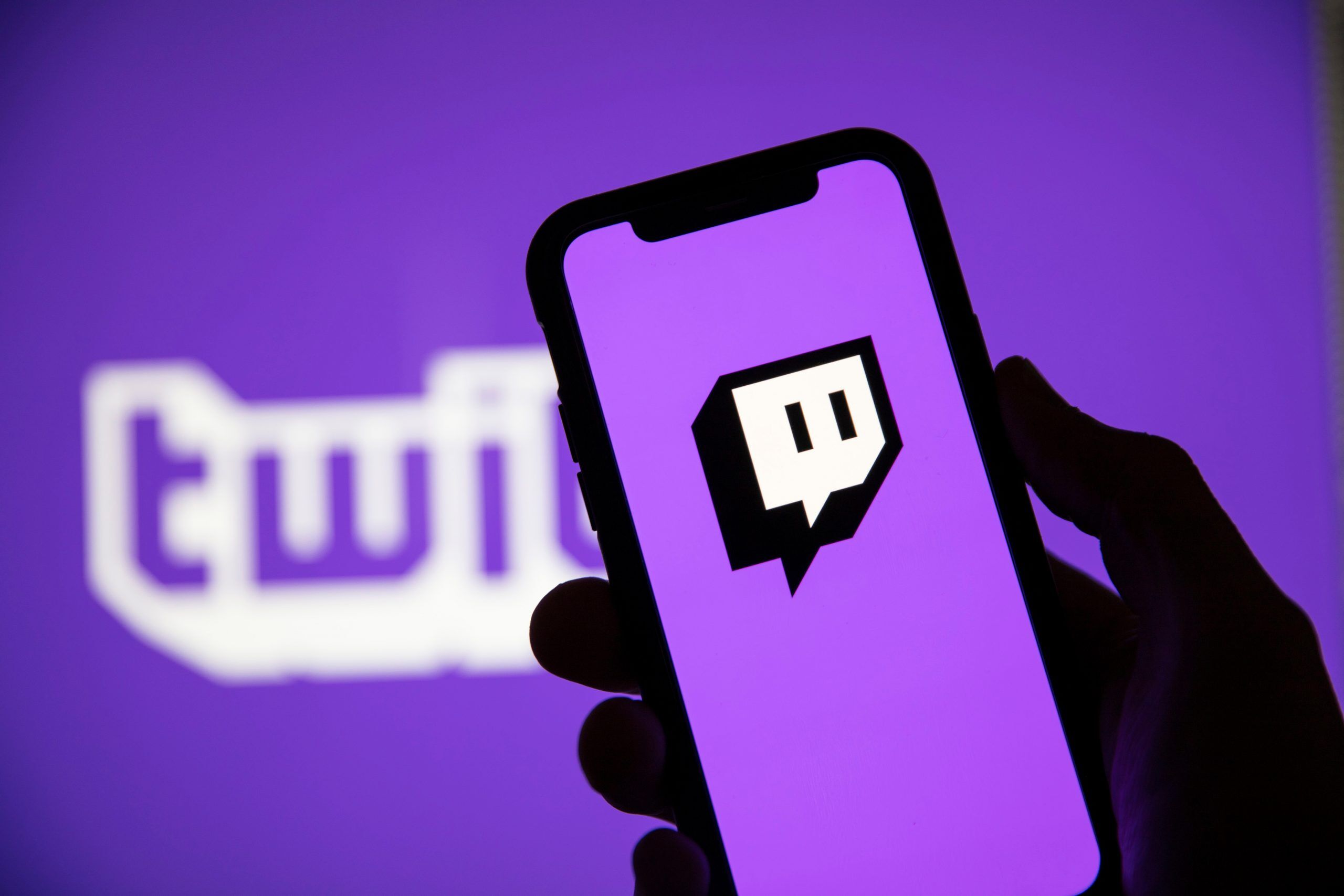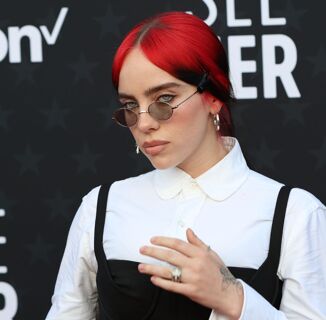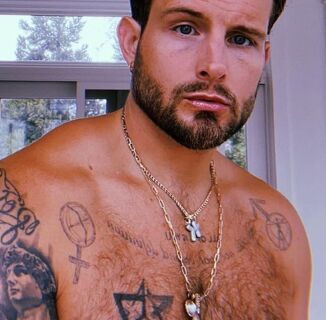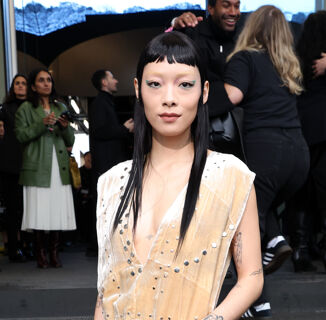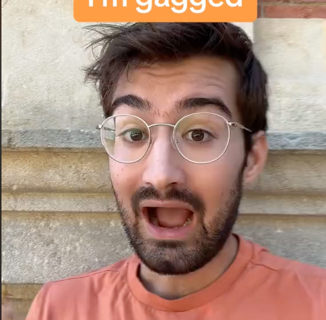Twitch likes to talk a big game when it comes to diversity and representation on their platform, but time and again they have failed to protect their content creators or reliably promote diverse voices. Harassment on the platform is nothing new for anyone who isn’t a cishet white man, but recent months have seen a sharp increase in targeted hate raids. It’s left many queer and POC creators questioning whether they can remain on the platform, as their calls for change from Twitch have largely been met with platitudes. So, what the hell is going on?
Twitch, Pride, and Diversity
Twitch is an online platform where content creators can live stream to viewers around the world, often focusing on video game and art content. This year, Twitch kicked off Pride month with a big June 1 fanfare announcing “LGBTQIA+ Pride is Out Here on Twitch.” Their push included spotlighting queer creators, recommendations on streaming for charities, educational information on the difficulties facing the LGBTQ+ community, and an urging for creators and mods to report hateful content to help them crack down on harassment. This came on the heels of Twitch finally introducing a long awaited range of over 350 diversity tags aimed at helping marginalized streamers such as members of the queer community, the neurodivergent, and people of color identify themselves and help others to find their content.
So, everything is now great, and Twitch is a space where everyone is free and clear to be their authentic selves, right? Well, no. Unsurprisingly, these changes by Twitch have been, if not performative, ultimately ineffectual and potentially harmful. The new tags that have made it easier for Twitch’s audience to find streamers from marginalized groups, but it has also made it easier for people to target those groups for harassment.
While Twitch have suggested that they’re working to find a solution to this issue, they had no system in place to mitigate harassment before rolling out the tags. This is a notable failure on their part, given that they were clearly aware that something like this could happen. For a long time, they resisted adding the transgender tag in particular, citing concerns in December of 2020 that it would lead to hate being directed towards trans streamers on their platform. While Twitch acknowledges that their platform is home to this sort of negativity and prejudice, they have historically sought to avoid uplifting people who might be victims of it, rather than removing the oppressive element that might perpetuate it.
Streamers could obviously make themselves harder to find by not using these new diversity tags. The first problem with this is that would also make it harder for their audiences to find them. The second problem is that ceasing to use the tags would be akin to hiding their identity, which is something many people already have to do far too much. Instead, content creators are having to either work through hate raids and harassment or are being forced off the platform.
What are Hate Raids?
Raids are a tool on Twitch that allows a streamer who is ending their stream to send all of their viewers over to another channel. The idea behind it is to help build community among streamers and help content creators to support other creators that they like (it also helps Twitch to keep all of their audience active on Twitch to keep that ad revenue coming in). It can be used to wholesome effect where a streamer might drop a few viewers into their friend’s stream, or a larger streamer might pick someone with very few viewers on a similar game and suddenly add hundreds of viewers to their audience, often making their day.
However, this tool can also be weaponized. Certain individuals with large viewerships have targeted marginalized creators and had their audiences spam a creator’s chat with hateful messages and slurs. However, the perpetrators are not limited to creators with large audiences, as it has been revealed that Twitch’s security can easily be circumvented to allow someone to create thousands of bot accounts in a matter of minutes which can then be used to create a massive hate raid. The problem has reached a point where many streamers are finding that they can’t reliably stream without being hate raided, and are often the victims of multiple hate raids within a single stream.
To help understand the impact that these hate raids are having on the community, I spoke with Mia, a creator from the UK who streams on Twitch under the name Miabyte:
“What people don’t seem to realize is that any time a hate raid happens it essentially derails a stream for 15-20 minutes. The slurs for some can be water off a duck’s back at this point, although this isn’t true for many others. Even with that aside it still forces creators to stop what they are doing, limit access for new viewers to interact with the stream and have mods clear/ban hundreds of accounts. This causes an incredible strain on the streamer, mod team, and viewers.”
For smaller streamers who don’t have mods, the result can all too often be that they have to end their stream, and they can be reluctant to stream again for fear of receiving more hateful messages from bigots or bots. The hate raids reliably target anyone who is not a cishet white male, and the goal appears to be harassment and distraction that lead to exhaustion that drives marginalized creators from the platform in an attempt to preserve the white male gamer image that is behind harassment campaigns like Gamergate.
Again, none of this is new, but the recent months have seen a drastic increase in behavior like this. Twitch has consistently failed to introduce reliable resources for streamers to avoid this harassment. All of this also comes after the hate that many marginalized streamers received in response to Twitch’s rotating replacement of the PogChamp emote.
“Twitch is our escape, somewhere where we can be ourselves, enjoy ourselves outside of the horrors of the irl world, and that’s before you take into account that we’re marginalized creators who already put up with so much hate on the daily.”
What Can Streamers Do?
Some people have been quick to point out that Twitch does have tools in place that are designed to help with this. However, all of these tools can either be bypassed or have a negative effect on their stream. Specific words can be banned from chat, but that can be easily ignored by alternate spellings. Users can be banned, but that takes time and energy and can only be done after the problem has begun. And chat can be changed to subscriber-only, so that only people who have provided monetary support to the channel can post messages in chat, but that reduces the ability to foster engagement with the creator’s audience and can leave people feeling priced out of the experience.
One of the key issues here is that for many of those targeted, steaming is not a hobby but a full or part-time career. Marginalized creators often see discrimination in the workforce and are unable to get hired in traditional markets, so spaces like Twitch (just like OnlyFans) can give them another opportunity to make a living. Beyond the capitalist aspect of it, as Mia put it:
“For me and many others, Twitch is our escape, somewhere where we can be ourselves, enjoy ourselves outside of the horrors of the irl world, and that’s before you take into account that we’re marginalized creators who already put up with so much hate on the daily.”
Mia has been streaming since 2016 and became a Twitch Partner in 2018. Achieving and maintaining a Twitch Partnership is no small feat: a streamer has to stream for at least 25 hours a month across at least 12 different days while averaging at least 75 viewers; they then have to be evaluated by Twitch to be approved. As well as being draining and emotionally damaging, the hate raids genuinely threaten Mia’s livelihood.
“People can only take so much, and I fully expect casual viewers to find other channels/mediums where they can be entertained without being subjected to harmful abusive language. I’ve definitely seen a general decline in viewership that started with the hate raids, and that worries me because I and others rely on Twitch for our incomes.”
With Twitch failing to provide timely support and workarounds or find a way to remove the more hateful individuals from their platform, the question arises: why stay on Twitch? There are other streaming platforms; Facebook and YouTube are both increasing their presence in that market, and not all platforms take the huge 50% cut of steamer’s revenue that Twitch does (note: Twitch is owned by Amazon). However, many feel that leaving would let the trolls win, allow Twitch to become another cishet white space, and allow marginalized voices to be pushed into the dark. Beyond that, there are just logistical and financial issues with moving platforms, even when it seems like it might be necessary:
“If things continue the way they have been there doesn’t seem like much reason to stick around. Which breaks my heart, I love twitch, I love the community that I’ve built and I wouldn’t want to give that up. For me personally, it’s whether or not this is mentally and financially sustainable. But at the same time, that’s exactly what the bigots orchestrating these hate raids want. Driving marginalized creators off of the platform. So there’s also definitely a feeling of defiance in me. I can’t and won’t let them win.
“I’m currently looking at branching out on other platforms but for me and others a lot of what we built, the communities we have fostered live on Twitch. It’s also the same reason many of us can’t just up and move to a different platform, even if those platforms provide a much better revenue cut compared to what twitch offers. Personally, I built my community over the 5 years I’ve been on Twitch and it would be an incredible ask to have to essentially start again from scratch. It is a long-term solution but does nothing to help creators now who were not prepared for this or given the proper tools to protect themselves.”
The hate raids reliably target anyone who is not a cishet white male, and the goal appears to be harassment and distraction that lead to exhaustion that drives marginalized creators from the platform
#ADayOffTwitch – What Is Twitch Doing?
As harassment increased exponentially and more and more reports and complaints were sent to Twitch, they eventually began to speak to the issue on Twitter. This merely took the form of reiterating statements that shouldn’t have to be said (regarding Twitch not wanting to be a platform that welcomes “hateful attacks”) and promising an open dialogue that has not really appeared.
No one should have to experience malicious and hateful attacks based on who they are or what they stand for. This is not the community we want on Twitch, and we want you to know we are working hard to make Twitch a safer place for creators. https://t.co/fDbw62e5LW
— Twitch (@Twitch) August 20, 2021
Pushed to breaking point, streamers staged a walkout on September 1 using the hashtag #ADayOffTwitch. The movement was led by the streamers RekitRaven, ShineyPen, and LuciaEverblack, and was participated in by around 5,000 streamers (including Miabyte). Estimates suggest that Twitch received around 800,000 less viewers during its usual peak times as a result, down from around 4,300,000 the previous week.
With a movement in the works that was set to affect their bottom line, Twitch began to sit up and take notice. In observance of the protest, they delayed the start of their subscriber event (Sub-tember) by a single day to start on September 2 instead. They also reached out to RekitRaven, and in her tweet about meeting with them they seemed confident that there was real change in the works.
I am confident in this. @Twitch is listening and working actively on providing proactive tools to help combat these hate raids and are doing so with as much speed as possible
Change will happen.
Thank y’all for keeping the fight. The fight is not done but we are getting closer! https://t.co/84yTESdQOm— Raven is The Devil 😈 (@RekItRaven) August 26, 2021
However, in the meantime, the vast majority of creators are left in the dark as they continue to deal with extreme and unending harassment. Twitch has a lot of creators that are generating the company’s income and rely on them for their own livelihoods, but communication between them has been poor to non-existent. Even vetted Twitch Partners like Mia have no way to receive more direct reassurances from Twitch than what they post on Twitter and can only really contact Twitch’s support email.
“I’ve definitely seen a general decline in viewership that started with the hate raids, and that worries me because I and others rely on Twitch for our incomes.”
Possibly in response to the pressure exerted by #ADayOffTwitch, Twitch began to take further steps. On September 10 they filed a lawsuit against two Twitch users, CruzzControl and CreatineOverdose, who were identified as being behind some (but by no means all) of the hate raids. Twitch noted that the users had previously been banned but had repeatedly created new accounts and circumvented Twitch’s security systems, and that Twitch did not in fact know the real names of the users. While this might be the beginning of larger action by Twitch and could act as a deterrent to others, it is coming too late and reveals how vulnerable Twitch’s systems have been.
Until Twitch can instigate larger changes to their platform to ensure that users who wish to harass and discriminate against others can be permanently removed, the platform needs to instigate immediate stop-gap measures. When asked about what she would like to see from Twitch to resolve this issue, here’s what Mia had to say:
“What I want from Twitch is open and direct lines of communication. Far more frequently than what we’re currently getting. They need to use clear language [to] show that they are taking the situation seriously and actually care about their marginalized creators. Well outside of Pride Month or Black History Month where they can utilize us for clicks and PR. Immediate actions to help creators would also be something I would encourage such as letting creators having more control over what kind of accounts have access to chatting in their channel, be it account age, requiring 2FA [two-factor authentication], etc. and restricting the ability to tie multiple accounts to the same email address.”
She also doubled down on the demands made by #ADayOffTwitch that seek to make the platform safer for all marginalized communities.
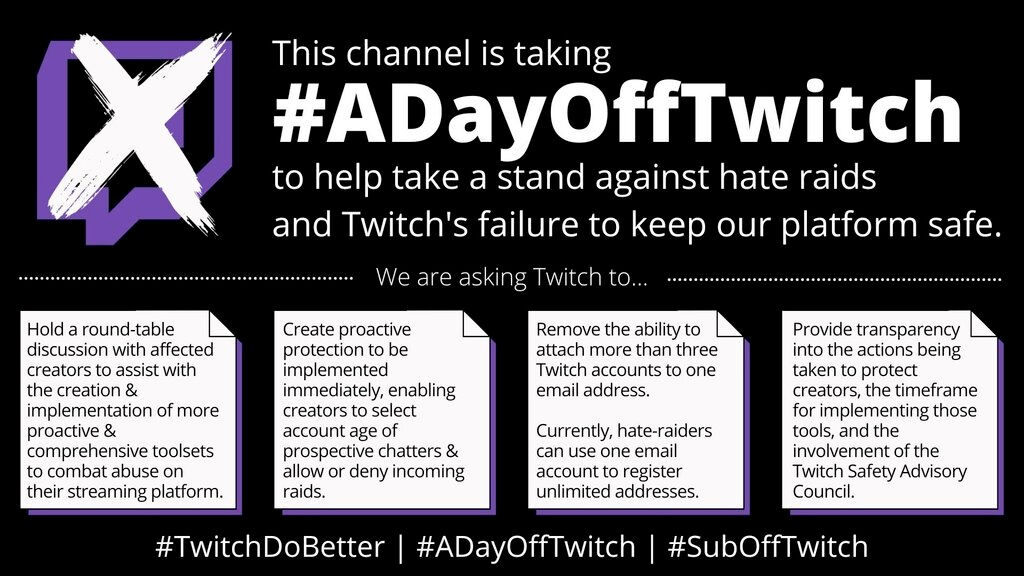
What Can You Do?
The actions taken by Twitch since #ADayOffTwitch demonstrate the power of individuals and the results of affecting a business’ bottom line. While maintaining their presence on Twitch, many streamers like Mia are setting up ways that you can support them outside of Twitch and get bonus content in return on sites like Patreon. If you wish to support a streamer, see what off-platform options they may have, as this allows more of your contribution to the streamer to go directly to the creator themselves, and also helps them to build up an income base that is not reliant on a single platform.♦
Thank you to Mia (Miabyte) for contributing to this piece. You can find her on Twitch, Twitter, Instagram, YouTube, Patreon, and at her website.
Help make sure LGBTQ+ stories are being told...
We can't rely on mainstream media to tell our stories. That's why we don't lock our articles behind a paywall. Will you support our mission with a contribution today?
Cancel anytime · Proudly LGBTQ+ owned and operated
Read More in Entertainment
The Latest on INTO
Subscribe to get a twice-weekly dose of queer news, updates, and insights from the INTO team.
in Your Inbox

